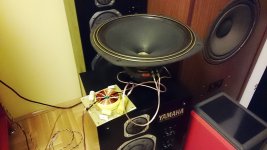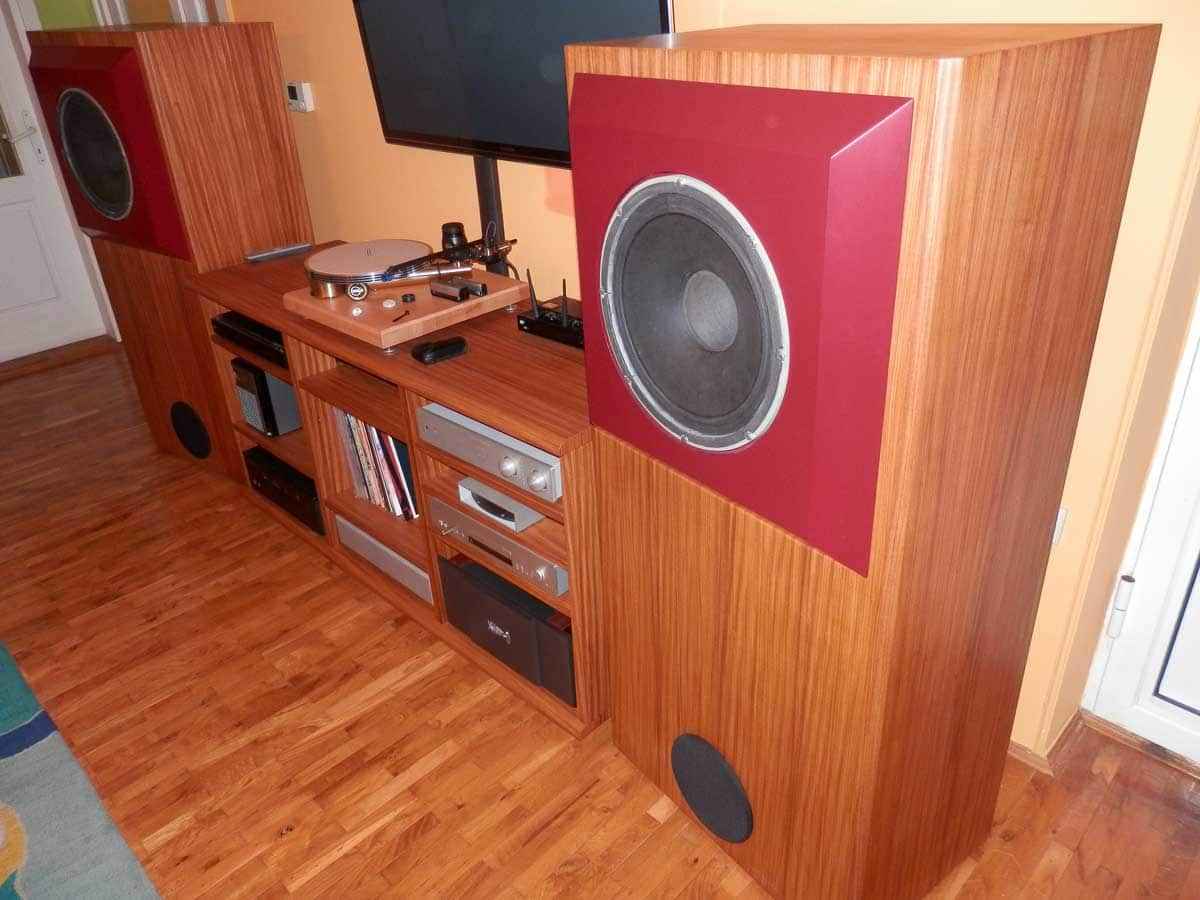It's not possible to add Tnnoy badge now. First - I don't have them, second - it's a risk to drill now a front side.
But it sounds heavenly...
Boris
But it sounds heavenly...
Boris
Yeah, very nice.
Unfortunatelly I don't have T/S parameters and request was to build exactly DMT15 cabinet. Further, perhaps I will build something like yours, because one pair of drivers is waiting for me.
At this moment I'm ok with this.
Thank you.
Boris
Unfortunatelly I don't have T/S parameters and request was to build exactly DMT15 cabinet. Further, perhaps I will build something like yours, because one pair of drivers is waiting for me.
At this moment I'm ok with this.
Thank you.
Boris
I have a pair of DMT15s which I thought were standard MK1 speakers,however on opening up the cabinets and having a look at the crossovers they are slightly different to the croosover diagram kindly submitted earlier. The treble crossover is as per the diagram, but the bass crossover has four poly type caps (yellow ICW I think), with values of 10microfarad for three of them but there is a fourth cap soldered in parallel to the other three, with a value of 6.8 microfarad making a total of 36.8 microfarads for the bass section. The crossover is all hard wired on a standard Tannoy DMT15 board version 1, I believe. Both of my DMT15 speakers have the same crossover configuration. Firstly can any tell me if Tannoy perhaps changed their design during the production run, and secondly what would the effect be on the crossover point of the additional 6.8 microfarad cap as I was considering unsoldering this cap returning the crossover as per the earlier submitted diagram.
On a slightly different note while inspecting inside the cabinets I found many of the felt damping panels had come away from the speaker walls hanging towards the center of the cabinet in mid air, particularly affecting the panels in the top areas of the cabinet probably due to their ageand weight. I have refixed all the damping to the sidewalls. On playing some music following this work I must say the bass tightness and quality showed quite an improvement, well worth checking on any older typespeakers.
On a slightly different note while inspecting inside the cabinets I found many of the felt damping panels had come away from the speaker walls hanging towards the center of the cabinet in mid air, particularly affecting the panels in the top areas of the cabinet probably due to their ageand weight. I have refixed all the damping to the sidewalls. On playing some music following this work I must say the bass tightness and quality showed quite an improvement, well worth checking on any older typespeakers.
........with values of 10microfarad for three of them but there is a fourth cap soldered in parallel to the other three, with a value of 6.8 microfarad making a total of 36.8 microfarads for the bass section. The crossover is all hard wired on a standard Tannoy DMT15 board version 1, I believe. Both of my DMT15 speakers have the same crossover configuration. Firstly can any tell me if Tannoy perhaps changed their design during the production run, and secondly what would the effect be on the crossover point of the additional 6.8 microfarad cap as I was considering unsoldering this cap returning the crossover as per the earlier submitted diagram.........
that's certainly original xover , and certainly one of iterations , non- documented in public , till now.
it's easy to try difference ......... with more uF in that position , bass driver is slightly more rolled of ( padded down) in turnover frequency area
hi guys. have any of you compared the mk1 to the mk2 (dmt15)
whats the difference sonically ?
I own a pair of dmt15 mark1 and would like to upgrade the crossover
hoping to get a bit more from the HF and a bit more LF ..
am i gonna achieve this by upgrading to the mk2?
whats the difference sonically ?
I own a pair of dmt15 mark1 and would like to upgrade the crossover
hoping to get a bit more from the HF and a bit more LF ..
am i gonna achieve this by upgrading to the mk2?
An externally hosted image should be here but it was not working when we last tested it.
Last edited:
Officially the difference is the nominal crossover point.
It is 1500Hz for MkI and 1100Hz for MkII.
Personally I think for a 15" the MkII crossover should be preferable.
In fact, on paper and without listening, I'd drop it down to 900Hz.
how will this affect the sound?
im gonna build new crossover and im in need of help 🙂
I am searching for an original 2 mH bass inductor (2) for my Tannoy DMT 15 speaker. Can anyone help me?
- Home
- Loudspeakers
- Multi-Way
- Tannoy System 15 mK1 crossover network



